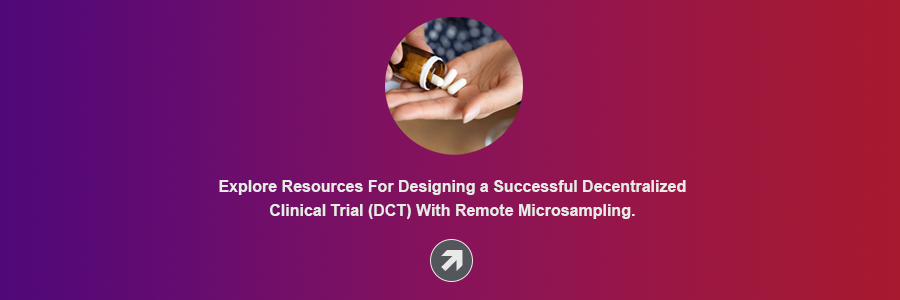Share this
3 ways that blood microsampling improves the patient experience
by Neoteryx Microsampling on Apr 26, 2016 9:00:00 AM
 In medicine, when a method comes along to get better and faster results, everyone can benefit—especially patients.
In medicine, when a method comes along to get better and faster results, everyone can benefit—especially patients.
Since even those of us involved in medicine as lab techs, research scientists or CEOs will end up as patients at certain times, we all share in the benefits of important technical medical advances.
One such benefit is dried blood microsampling, which is the collection of very small amounts of blood (e.g. 10 µL) typically via a finger-prick. After the blood microsample is dried it can be transported without cold chain or biohazard shipping requirements.
Microsampling: The Patient-Friendly Alternative to Blood Work
There’s a reason traditional venipuncture and testing is referred to as blood “work.” Patients must often travel to a facility or office, wait, undergo the needle stick and watch vials of blood drawn from a vein. This process is unnerving, costly, and time-consuming for the patient, which results in patients delaying their important lab visits.
Lab test data drives more than 70% of health decisions according to the American Journal of Pathology. Yet, many lab test orders don’t get filled in the U.S., likely due to the inconvenience and cost.
Keeping the above in mind, here are just three valuable patient benefits of dried blood microsampling:
- Patient outcomes improve, and lives may be saved: Since microsampling is more comfortable, more convenient, and quicker (sometimes even done at home by patients themselves), patients benefit from faster diagnoses and proper treatment begins more quickly.
- Low blood volume patients are not compromised: Very sick ICU patients can be put at risk due to traditional testing, where they often lose 2% of their blood volume to required daily testing, according to Johns Hopkins' Center for Bloodless Medicine and Surgery. Similarly, microliter blood collections are more suitable for neonatal and pediatric patients where there is a worry of decreasing total blood volume.
- Patient satisfaction and cooperation increase: More convenient blood draws with less pain, and the option of home sampling, leads patients to submit more readily to monitoring of chronic conditions and/or drug therapy. Better compliance improves both short- and long-term outcomes. Traditional blood draws are especially tough for the elderly with collapsed veins and oncology patients undergoing frequent draws, making microsampling a boon to their quality of life and mental attitude.

Share this
- Microsampling (205)
- Research, Remote Research (118)
- Venipuncture Alternative (106)
- Clinical Trials, Clinical Research (82)
- Mitra® Device (72)
- Therapeutic Drug Monitoring, TDM (50)
- Dried Blood Spot, DBS (38)
- Biomonitoring, Health, Wellness (31)
- Infectious Disease, Vaccines, COVID-19 (24)
- Decentralized Clinical Trial (DCT) (22)
- Blood Microsampling, Serology (21)
- Omics, Multi-Omics (19)
- Specimen Collection (17)
- Toxicology, Doping, Drug/Alcohol Monitoring, PEth (17)
- hemaPEN® Device (13)
- Preclinical Research, Animal Studies (12)
- Pharmaceuticals, Drug Development (9)
- Harpera® Tool (5)
- Industry News, Microsampling News (5)
- Skin Microsampling, Microbiopsy (5)
- Company Press Release, Product Press Release (4)
- Antibodies, MAbs (3)
- Environmental Toxins, Exposures (1)
- April 2024 (3)
- March 2024 (1)
- February 2024 (2)
- January 2024 (4)
- December 2023 (3)
- November 2023 (3)
- October 2023 (3)
- September 2023 (3)
- July 2023 (3)
- June 2023 (2)
- April 2023 (2)
- March 2023 (2)
- February 2023 (2)
- January 2023 (3)
- December 2022 (2)
- November 2022 (3)
- October 2022 (4)
- September 2022 (3)
- August 2022 (5)
- July 2022 (2)
- June 2022 (2)
- May 2022 (4)
- April 2022 (3)
- March 2022 (3)
- February 2022 (4)
- January 2022 (5)
- December 2021 (3)
- November 2021 (5)
- October 2021 (3)
- September 2021 (3)
- August 2021 (4)
- July 2021 (4)
- June 2021 (4)
- May 2021 (4)
- April 2021 (3)
- March 2021 (5)
- February 2021 (4)
- January 2021 (4)
- December 2020 (3)
- November 2020 (5)
- October 2020 (4)
- September 2020 (3)
- August 2020 (3)
- July 2020 (6)
- June 2020 (4)
- May 2020 (4)
- April 2020 (3)
- March 2020 (6)
- February 2020 (3)
- January 2020 (4)
- December 2019 (5)
- November 2019 (4)
- October 2019 (2)
- September 2019 (4)
- August 2019 (5)
- July 2019 (3)
- June 2019 (7)
- May 2019 (6)
- April 2019 (5)
- March 2019 (6)
- February 2019 (5)
- January 2019 (8)
- December 2018 (3)
- November 2018 (4)
- October 2018 (7)
- September 2018 (6)
- August 2018 (5)
- July 2018 (8)
- June 2018 (6)
- May 2018 (5)
- April 2018 (6)
- March 2018 (4)
- February 2018 (6)
- January 2018 (4)
- December 2017 (2)
- November 2017 (3)
- October 2017 (2)
- September 2017 (4)
- August 2017 (2)
- July 2017 (4)
- June 2017 (5)
- May 2017 (6)
- April 2017 (6)
- March 2017 (5)
- February 2017 (4)
- January 2017 (1)
- July 2016 (3)
- May 2016 (1)
- April 2016 (2)


No Comments Yet
Let us know what you think